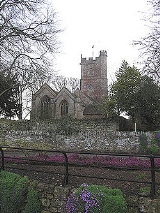
Church of St Margaret, Spaxton
Encyclopedia
The Church of St Margaret in Spaxton
, Somerset
, England has some parts from the 12th and 13th centuries but is predominantly from the 15th century, and was restored
in 1895. It has been designated as a Grade I listed building.
The three-bay nave
has a south aisle and includes Norman
herringbone stonework. It was extended in the 14th century. The chancel
has a south transept chapel and a north chapel which has been turned into a vestry.
The tower contains six bells, two of which date from the late 17th century. Parts of the clock mechanism are from the 16th.
The parish is part of the benefice
of Aisholt, Enmore
, Goathurst
, Nether Stowey
, Over Stowey
and Spaxton with Charlynch within the Quantock deanery.
Spaxton
Spaxton is a small village and civil parish on the Quantocks in the Sedgemoor district of Somerset, South West England.-History:Spaxton was part of the hundred of Cannington....
, Somerset
Somerset
The ceremonial and non-metropolitan county of Somerset in South West England borders Bristol and Gloucestershire to the north, Wiltshire to the east, Dorset to the south-east, and Devon to the south-west. It is partly bounded to the north and west by the Bristol Channel and the estuary of the...
, England has some parts from the 12th and 13th centuries but is predominantly from the 15th century, and was restored
Victorian restoration
Victorian restoration is the term commonly used to refer to the widespread and extensive refurbishment and rebuilding of Church of England churches and cathedrals that took place in England and Wales during the 19th-century reign of Queen Victoria...
in 1895. It has been designated as a Grade I listed building.
The three-bay nave
Nave
In Romanesque and Gothic Christian abbey, cathedral basilica and church architecture, the nave is the central approach to the high altar, the main body of the church. "Nave" was probably suggested by the keel shape of its vaulting...
has a south aisle and includes Norman
Norman architecture
About|Romanesque architecture, primarily English|other buildings in Normandy|Architecture of Normandy.File:Durham Cathedral. Nave by James Valentine c.1890.jpg|thumb|200px|The nave of Durham Cathedral demonstrates the characteristic round arched style, though use of shallow pointed arches above the...
herringbone stonework. It was extended in the 14th century. The chancel
Chancel
In church architecture, the chancel is the space around the altar in the sanctuary at the liturgical east end of a traditional Christian church building...
has a south transept chapel and a north chapel which has been turned into a vestry.
The tower contains six bells, two of which date from the late 17th century. Parts of the clock mechanism are from the 16th.
The parish is part of the benefice
Benefice
A benefice is a reward received in exchange for services rendered and as a retainer for future services. The term is now almost obsolete.-Church of England:...
of Aisholt, Enmore
Enmore, Somerset
Enmore is a village and civil parish west of Bridgwater on the Quantock Hills in the Sedgemoor district of Somerset, England. The parish includes the hamlet of Bare Ash.-History:The parish name means Duck marsh....
, Goathurst
Goathurst
Goathurst is a small village and civil parish in the English county of Somerset, around 3 miles from the town of Bridgwater. The parish includes the hamlets of Andersfield and Huntstile.-History:Goathurst was part of the hundred of Andersfield....
, Nether Stowey
Nether Stowey
Nether Stowey is a large village in the Sedgemoor district of Somerset, South West England. It sits in the foothills of the Quantock Hills , just below Over Stowey...
, Over Stowey
Over Stowey
Over Stowey is a small village and civil parish in the Sedgemoor district of Somerset, South West England. It sits in the foothills of the Quantock Hills, just below Nether Stowey and north-west of Bridgwater...
and Spaxton with Charlynch within the Quantock deanery.

